Brian Meert's Blog, page 111
July 31, 2018
Facebook Signs Legal Agreement That Prevents Exclusion of Groups
 July 30, 2018
July 30, 2018Anna Hubbel
Facebook Signs Legal Agreement That Prevents Exclusion of Groups. #facebook #socialmedia #news
Click To Tweet

Facebook recently signed an agreement that stipulates third-party advertisers can no longer use ad targeting tools to exclude certain groups. The agreement, made with the office of Washington Attorney General Bob Ferguson, protects groups such as ethnic and religious minorities, immigrants, and the LGBTQ from segregated targeting. Facebook has 90 days to put this new policy into full effect nationwide, according to Ad Week.
Pro Publica first discovered that third-party advertisers, such as those working in housing, could exclude certain groups from seeing ads using Facebook’s targeting tools. This discovery led to a 20-month investigation by Ferguson’s office.
Last November, Pro Publica followed up and found that advertisers could buy a slew of rental housing ads and use Facebook’s tools to exclude African Americans, Jews, and handicapped individuals. As a result, Facebook put a temporary block on self-reported targeting to avoid such discriminatory practices while it investigated the issue. Ferguson’s office, however, learned that more groups were being excluded based on sexual orientation, religious affiliation, and veteran status. Clearly, it was still an issue.
Many worry that the legal agreement Facebook signed may create problems for organizations that need to target protected groups. In an Ad Week article, Jen Brady, vice president of media for Periscope, said, “Targeting by race is helpful when reaching dedicated ethnicities, such as with a Hispanic-focused campaign versus a general marketing campaign, or by gender. Being able to reach those audiences effectively is key. There are some advertisers who want to focus on religion.”
Agencies should become aware of the new agreement’s effect on their Facebook ad campaigns, on whether there may be delays in ad review processes as a result.
An anonymous agency executive told Ad Week that it’s possible to use Lookalike Audiences to work around the targeting changes. The executive said in the article that Lookalike Audiences are “much more sophisticated and work better in general” than Facebook’s ad targeting options that will be affected by the legal agreement.
The office of Washington Attorney General Bob Ferguson released the following stipulations for the Facebook platform:
In addition to housing, credit, and employment ads, Facebook will no longer provide advertisers options to exclude ethnic groups from advertisements for insurance and public accommodations. Public accommodations include all businesses open to the public. Places of public accommodation include auto dealers, beauty salons, restaurants, colleges, hospitals, and professional sports stadiums.
Facebook will no longer provide advertisers tools to discriminate based on race, creed, color, national origin, veteran or military status, sexual orientation, and disability status. These exclusion options will not be present on any advertisement for employment, housing, credit, insurance, and places of public accommodation.
These changes will be permanent and legally binding. The assurance of discontinuance requires Facebook to remove these exclusion options for any advertiser whose ad Washingtonians may have the ability to see. According to Facebook, these changes to its platform will be nationwide.
According to the assurance of discontinuance, Facebook will fix its advertising platform to remove the unlawful targeting options within 90 days. The social network service will pay the Washington State Attorney General’s Office $90,000 in costs and fees.
Facebook’s agreement with the Washington State Attorney General is one of the many reforms to improve the platform. The company recently participated in the Data Transfer Project, giving users more control over their data, and rolled out a new policy that removes posts inciting violence.
The post Facebook Signs Legal Agreement That Prevents Exclusion of Groups appeared first on AdvertiseMint.
July 30, 2018
Here Are the Social Media Advertising Options for Cannabis Companies
 July 30, 2018
July 30, 2018Anna Hubbel
Here Are the Social Media Advertising Options for #Cannabis Companies. #marijuana #weed #business
Click To Tweet

With more and more states legalizing marijuana, especially medical marijuana, more cannabis companies are emerging, looking for ways to reach their desired audience. But it’s challenging to be in the cannabis business because there are so many advertising restrictions. How can you grow your business if you can’t promote it?
Although social media platforms allow organic posts about recreational drugs, many of those platforms prohibit ads about recreational substances under any context. You can explore the social media advertising options available to you using this list of platforms and their policies on cannabis ads.
According to Pinterest’s advertising policies, Pinterest never allows ads that promote the sale or use of illegal or recreational drugs. However, the company says it does allow ads promoting hemp and CBD-only byproducts of cannabis that don’t contain THC.
A basic search on the platform shows that Pinterest does allow organic content containing information about cannabis that are artistic or educational. Therefore, you can share organic content about those substances on Pinterest.
Twitter’s advertising policies say the platform does not allow ads that promote drugs and drug paraphernalia globally. Examples the policies provide include
Illegal drugs
Recreational and herbal drugs
Accessories associated with drug use
Drug dispensaries
Depictions of hard drug use
Because Twitter does not allow ads about recreational and herbal drugs, it will not allow companies to advertise their cannabis products. However, Twitter appears to allow organic tweets that contain keywords like “marijuana.” In fact, there’s a Twitter page called Weed Tweets and a page called Cannabis Culture that includes tweets about cannabis. If you want to promote medical cannabis on Twitter, you can do so organically instead.
Snapchat
Snapchat’s advertising policies do not offer specific examples, but Snapchat does prohibit ads about illegal or recreational drugs or drug paraphernalia. This means Snapchat won’t allow your cannabis ads to run. However, if you search for “marijuana” or “cannabis” on Snapchat Discover, the platform appears to allow content about those recreational drugs as long as they don’t promote illegal activity.
YouTube
Although YouTube’s Community Guidelines does not specify that you can’t post content about cannabis, it does stipulate that harmful or dangerous content is prohibited. If you’re sharing content about medical marijuana, for instance, you are allowed to do so.
YouTube Help does say video content that promotes illegal drugs and dangerous products or substances is “not suitable” for advertising on the platform. However, you are allowed to share videos that discuss such substances for educational, documentary, and artistic purposes as long as they do not glorify illegal or dangerous use of the product.
Although Reddit’s Content Policy says the platform prohibits content that promotes illegal activities, it does not specifically state whether or not content about cannabis is prohibited. If you intend to share content about cannabis products in an educational or legal manner, it isn’t an issue.
However, the platform’s Advertising Policy says ads promoting the sale or use of recreational drugs or substances is not allowed. If you have such a product you want to promote, you cannot advertise it on Reddit.
The advertising policies for the Google Network prohibit the promotion of dangerous products or services, including recreational drugs, either chemical or herbal. The policies do not specify whether Google exempts educational or artistic content about those types of drugs. Therefore, it is unlikely that you can advertise cannabis products on the Google Network.
If you want to use Google Blogger to write content related to cannabis, you may do so, but only if the blog does not encourage illegal or dangerous content. Google will delete your content if it violates this stipulation.
Last but not least, Facebook’s advertising policies also prohibit the promotion of illegal or recreational drugs. The platform has been working harder to give users a safe experience, so even if your company promotes healthy use or educational information about cannabis, the company will not allow it.
However, if you search for the words “marijuana” or “cannabis” on Facebook, you’ll find business pages with organic content about the substances. As long as the content is educational or informative, Facebook appears to allow it. But if you choose to market your cannabis company on Facebook, proceed with caution because the company is strict about the type of content it allows.
If you want to promote a product like medical marijuana on any of the platforms discussed in this article that prohibit such products, it’s prudent to contact the platform to review the material you want to advertise. The most important factor to consider is the message and presentation of the organic content you want to post on each platform. Slightly suggesting or encouraging illegal or harmful behavior will result in consequences.
What Now?
The advertising opportunities for cannabis businesses are very limited, but don’t be discouraged. Research extensively on what’s allowed and contact the social media company whose platform you want to advertise on to see if your content is permissible. Cannabis is a controversial topic, but that doesn’t necessarily mean all cannabis companies are banned from social media circles altogether.
To learn more about Facebook’s restrictions for advertising, see the 13 types of businesses that can’t advertise on Facebook.
The post Here Are the Social Media Advertising Options for Cannabis Companies appeared first on AdvertiseMint.
July 27, 2018
Advertisers May Soon Run Ads in Facebook Stories
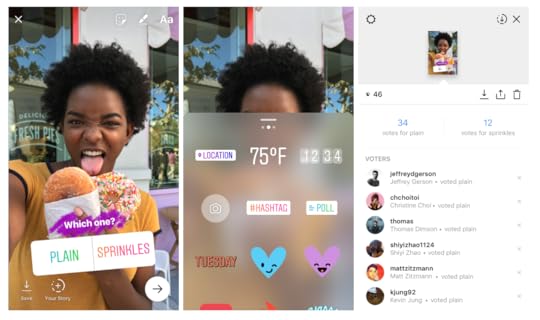 July 27, 2018
July 27, 2018Anna Hubbel

Facebook likes to give us teasers now and then for products and features we can expect sometime in the near future. This week, Facebook announced that advertisers will soon be able to run ads on Facebook Stories. With this new ad placement, Facebook also announced that advertisers will be able to repurpose Stories creative across each of its platforms since the formats are so similar. For example, an Instagram Stories ad can be placed on Facebook Stories, helping you maximize your reach.
The Popularity of Stories
Instagram Stories has grown in popularity to both users and businesses. Facebook uses Tropicana’s success as an example. The company ran video ads on the platform for a summertime campaign and achieved an 18-point lift in ad recall. Additionally, the campaign achieved a 15-point lift in purchase intent among men.
Overstock also used Instagram Stories to run video ads to boost sales and reach new customers. The campaign received an 18 percent higher return on ad spend and a 20 percent decrease in cost per acquisition.
“People use stories on Instagram to discover and engage with content they care about, and this includes content from businesses,” the article reads. It adds that one-third of Instagram Stories with the most views are those by businesses.
But Instagram Stories isn’t the only platform that offers this popular format. The company introduced the format to Messenger last year, followed by Facebook and WhatsApp. More than 150 million users now use Facebook Stories. Clearly, businesses could benefit greatly by expanding their Stories campaigns to Facebook.
“The consumer shift to stories is clear,” the article concludes, “and now is the time for businesses to meet their customers where they’re sharing and discovering things they love.”
The post Advertisers May Soon Run Ads in Facebook Stories appeared first on AdvertiseMint.
July 26, 2018
Christmas in July: A Look at Snapchatters’ 2017 Holiday Behaviors
 July 26, 2018
July 26, 2018Anna Hubbel

The holiday season is the most exciting time to shop. Although it’s only July, and you’re not even thinking about your gift lists yet, as an advertiser, you want to get a jumpstart on your holiday campaigns. To do that, you need to analyze shoppers’ past behaviors, for example, how they interacted with businesses, brands, and social media platforms during that time.
Snapchatters, in particular, played a major role for advertisers during the holidays last year. In fact, active Snapchatters bought 20 percent more items than any other average consumer not active on Snapchat. Additionally, active Snapchatters are 64 percent more likely to holiday shop on Black Friday than non-active users. To top it off, US Snapchat users made 850 million shopping trips in 2017 during the Black Friday weekend.
Snapchat g recently shared charts and statistics about Snapchatters’ behaviors during the holiday season in 2017. Here are some of the highlights.
Store Foot Traffic
Snapchat found that last year teen users shopped more at apparel stores while users 21 and older shopped more at big box stores. Additionally, the following stores saw a significant increase in foot traffic volume:
Victoria Secret: 15x more traffic
Target: 13x more traffic
Macy’s: 5x more traffic
Hot Topic: 4x more traffic
Hollister: 2x more traffic
Last Minute Shopping
The week before Christmas last year, Snapchat users exhibited different shopping patterns. They shopped at jewelry, beauty, discount, and printing stores. Specifically, MAC’s makeup gift packs and Staples’ shipping and gift card printing services were most popular during that stretch before Christmas. During the week before Christmas, the following stores received high-volume foot traffic:
MAC: 15x more traffic
Staples: 6x more traffic
Kay Jewelers: 5x more traffic
Marshalls and TJ Maxx: 5x more traffic
Barnes & Noble: 3x more traffic
Additionally, since last-minute holiday shopping takes a lot of work and makes people hungry, Snapchatters were frequenting popular food chains while out and about. According to Snapchat, the food chains visited the most last year the week before Christmas were
Starbucks
Dunkin’ Donuts
Subway
McDonald’s
Burger King
Dairy Queen
Taco Bell
Wendy’s
Chipotle
Jack in the Box
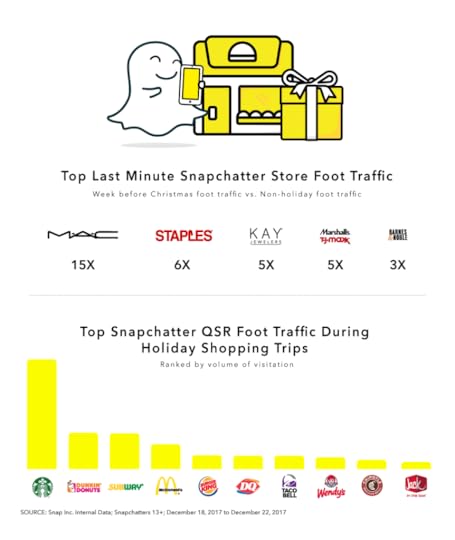 Image Courtesy of Snapchat
Image Courtesy of SnapchatHoliday Visits to the Movies
Whether they finished their holiday shopping, waited until the last minute, or did not partake in the holiday shopping tradition, Snapchat users spent a lot of time at the movies when they weren’t shopping. Last year, Snapchat users frequented movie theaters on Black Friday and the Friday before Christmas. In fact, their visits both times were higher than the same day the week prior.
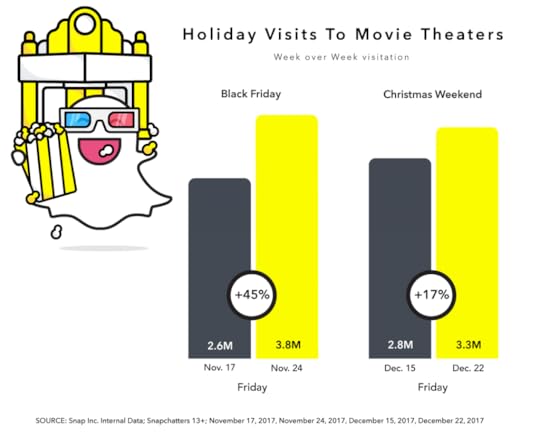 Image Courtesy of Snapchat
Image Courtesy of SnapchatRinging in the New Year
Snapchat users have a special way of celebrating the New Year. In particular, Snapchat found that users celebrate at popular tourist attractions like Disneyland, Universal Orlando, and the Mall of America. This suggests that they enjoy big celebrations where there are fireworks and crowds.
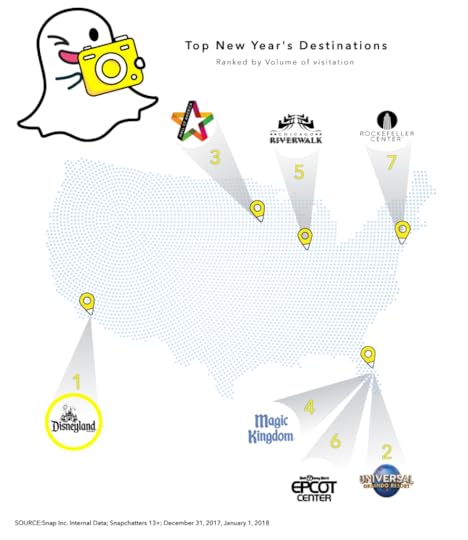 Image Courtesy of Snapchat
Image Courtesy of SnapchatStart Your Campaigns Early
Although your audiences may not be thinking of the holidays yet, you should start doing so. Think of where and when you should market to them. For example, if you own a food chain, you want to amp up your campaign during the week before Christmas to reach hungry last-minute shoppers. Or if you’re promoting a movie, enhance your efforts in the days leading up to Black Friday and the Friday before Christmas. You can create filters or geofilters with fireworks to target users at New Years Eve. Snapchat gives you a lot of creative flexibility to deliver your holiday campaign when and where it will be best received.
The holidays are just around the corner. It’s time to get to work!
The post Christmas in July: A Look at Snapchatters’ 2017 Holiday Behaviors appeared first on AdvertiseMint.
July 25, 2018
Facebook Shares Q2 2018 Report
 July 25, 2018
July 25, 2018Anna Hubbel
Facebook Shares Q2 2018 Report. #facebookq22018 #q22018 #investors
Click To Tweet

Today, Facebook shared the financial highlights of its second quarter 2018 earnings report. The report reflects the numbers for the quarter ending June 30, 2018.
For advertising revenue, Facebook reported $13.23 billion, a 42 percent year-over-year change. In contrast, second-quarter advertising revenue in 2017 was $9.32 billion. For 2018, daily active users (DAU) were 1.47 billion on average for June 2018, which is an increase of 11 percent year over year. Monthly active users (MAU) were 2.23 billion by the end of the quarter, which was also an increase of 11 percent year over year.
Additionally, the report shows that mobile advertising revenue made up about 91 percent of total advertising revenue for Q2 2018, compared to 87 percent in Q2 2017.
In the webcast, Facebook continued to stress its efforts to make the platform safer and more transparent while also helping users connect.
“Our community and business continue to grow quickly,” Mark Zuckerberg, Facebook founder and CEO, said in the official press release. “We are committed to investing to keep people safe and secure, and to keep building meaningful new ways to help people connect.”
When asked if the privacy changes Facebook made that were inspired by the EU’s General Data Protection Regulation (GDPR) have impacted advertising, Facebook said it’s still too early to know for sure. The company first announced the new privacy protections in April this year. However, the company does not believe there will be a huge negative impact on advertising revenue in the long run.
Additionally, the company shared that it is happy about the growth of its other platform, Instagram, and sees it as overall contributing to the success of Facebook.
The third quarter of 2018 will end on September 30, at which time advertisers will know a bit more about how Facebook’s privacy efforts are impacting its success.
The post Facebook Shares Q2 2018 Report appeared first on AdvertiseMint.
Which Platform Is Best for Your Social Media Campaign?
 July 25, 2018
July 25, 2018Anna Hubbel
Which Platform Is Best for Your Social Media Campaign? #digitaladvertising #digitalmarketing #socialmedia
Click To Tweet

There are so many ways to advertise these days, so many platforms to advertise on. But just because there are so many options doesn’t mean you should use every single one. Success depends greatly on your business, organization, and campaign goals.
Rather than dive unknowingly into a campaign on each platform to see what works and what doesn’t, you should know what makes each platform different and what each offers in terms of advertising benefits. For example, if you want to reach younger audiences, a campaign on Instagram or Snapchat would work better than a campaign on Facebook or LinkedIn. If you want more ad format options, Facebook has more variety than LinkedIn or Pinterest. As you can see, there are a lot of factors to consider.
Before we talk about which platform is best for you, first consider these questions:
Know your goals or objectives. What do you want to achieve through your social media campaign? More web traffic, engagement, or conversions?
Know your audience and its behaviors. Are you targeting men, women, or both, teenagers, music lovers, or fashionistas?
Know the focus and offering of each social platform. For example, Twitter’s focus is trending topics and real-time news snippets. Instagram and Pinterest, on the other hand, focus primarily on visual, lifestyle, and DIY content. Facebook is more about friends and family, whereas LinkedIn is about networking and career development.
Know your budget. Some social media platforms require a minimum spending budget, so be aware of how your budget compares. You also need to know how much you are able to spend on ad creative because some platforms require more work than others.
Now that we’ve covered the pre-logistics, let’s look at each social media platform to see which aligns best with your goals.
Use Facebook If…

You need to create ads in bulk and frequently A/B test
You want access to a wide array of ad formats, such as Dynamic Ads, Canvas Ads, and Carousel Ads
Your focus is sharing knowledge
Your focus is sharing lifestyle content
You want to promote how-to videos that show your product or service in action
You want extensive audience targeting capabilities
Your primary audience ranges from young to older demographics
Your message is family-oriented
Use Instagram If…

You run an e-commerce business
Your business relies heavily on visuals to sell products or services
Your primary audiences include Millennials and Gen Zs
You want to share company updates
You want to share behind-the-scenes footage
You like the Stories format
You want the targeting capabilities of Facebook
You want to sell products directly through the platform
Use Pinterest If…
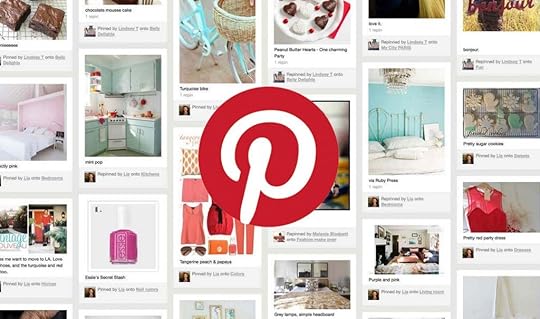
You run an e-commerce business
Your target audience is primarily women
Your focus is sharing lifestyle content
You want to use creative and visual inspiration to reach your audience
You want to drive traffic to your website
You want to sell products on the platform
You own a small brand, and you want to reach your audience organically
Use LinkedIn If…

You own a B2B business, and you want to reach industry professionals
Your focus is networking
You’re interested in sharing industry and career development news
You want to target audiences based on job title, industry, or interests
You want to use video ads to increase engagement or drive lead generation
Use Twitter If…

You want to share short-term promotions
You want sales that are timely
You want to share company updates
You’re interested in starting real-time conversations
You plan to stay up-to-date and engage with trending topics
Your focus is customer service
You’re good with hashtags
You want to reach your audience organically
Use Snapchat If…

You run an e-commerce business
You want your business to be perceived as authentic, spontaneous, and silly
Your business relies heavily on visuals to sell products or services
You don’t plan to use much text in your ads
Your primary audiences include Millennials and Gen Zs
You want to share company updates
You want to share behind-the-scenes footage
You like the Stories format
You want to sell products directly through the platform
Which Platform to Choose?
Although social media advertising requires some trial-and-error, you shouldn’t go into it completely blind. Plan the things you need to know and the things you need to try. Be ready to switch to a different platform if something you thought you researched fully doesn’t work out. It’s all a part of the growing process, and as with all processes of this sort, the end result will be worth it.
The post Which Platform Is Best for Your Social Media Campaign? appeared first on AdvertiseMint.
How to Reach Snapchatters During Back-to-School Season
 July 24, 2018
July 24, 2018Anna Hubbel

Last year, a surplus of more than 130 million hours was spent on Snapchat in the US for back-to-school season. It’s one of the two biggest shopping times of the year, affecting 29 million households. In 2017, back-to-school shopping ranked up $27 billion in US sales, and Snapchat is a major player.
According to the platform’s business blog, Snapchat had more daily mobile sessions per user on average than Facebook, Messenger, Instagram, or Twitter. In 2017, Snapchat had a 20 percent increase in Filter and Lens views daily during back-to-school season. As August 2018 quickly approaches, 60 percent of prospective back-to-school families are already shopping to prepare. Clearly, the marketing benefits are high if you choose to use Snapchat for your back-to-school advertising strategy this year.
Gen Zs, the generation of young teens on Snapchat getting ready for school, are highly influential in their families’ spending habits. According to Snapchat, 96 percent of Gen Z parents agree that the teens in their family have a significant impact on family spending. With this in mind, you want to market your back-to-school products and sales to Gen Zs, and Snapchat is the best way to reach them.
Here’s How
There are various approaches to marketing to your back-to-school audience, according to Snapchat.
Use friend-to-friend ad formats. Snapchat says 87 percent of users say their close friends are the most influential when it comes to trying new brands, products, or services. Using ad formats that key into those friendships can help you drive awareness for your product or brand. For example, Red Bull used a back-to-school filter to seamlessly market its brand while giving users something fun to use when socializing with each other through the app.
 Photo Courtesy of Snapchat
Photo Courtesy of SnapchatRun a relatable back-to-school campaign. Five Star, for example, engaged with Snapchatters during the peak season through filters and Snap Ads promoting a #StrengthNotStress campaign. The campaign shared students’ stories about dealing with the typical stresses of going back-to-school. According to Snapchat, the Snap Ads that Five Star used received a 9.4 percent swipe-up rate and a swipe-to-video completion rate of 23.8 percent. Additionally, Five Star’s filter sparked 3.7 million impressions.
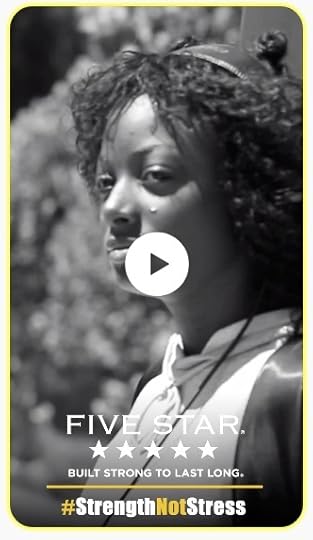 Photo Courtesy of Snapchat
Photo Courtesy of SnapchatUse Snap Ads and Story Ads to improve your reach and drive action. With Story Ads, you can showcase your back-to-school products in a collection of 3 to 20 Snaps. When users swipe up on one of the Snaps, they can access your web store or app store listing. With Snap Ads, you can reach users in between Stories they view. When they swipe your ad, they are directed to your product page or wherever you want them to go on your mobile site.
Use the Snap Pixel to optimize the performance of your campaign. Snap Pixel allows you to track purchases made through your Snapchat ads so you can see what’s working and what isn’t.
Use Snapchat’s location and lifestyle targeting options. Target users in the “Colleges & Universities” location category or the “Parents & Family Focused” lifestyle category. This will ensure that your brilliant back-to-school creative is reaching the right people who are most likely to interact with it.
Achieve the best campaign results ever this season and be a back-to-school winner!
The post How to Reach Snapchatters During Back-to-School Season appeared first on AdvertiseMint.
July 24, 2018
Facebook Announces Participation in Data Transfer Project
 July 24, 2018
July 24, 2018Anna Hubbel

Facebook announced another effort in giving users more control over their data. Although the network has already made it easier to access privacy settings and manage data, transferring data from Facebook to another social network or service was still a problem. Recently, Facebook announced that it is participating in the Data Transfer Project, along with major organizations including Google, Microsoft, and Twitter. This collaboration makes it easier for anyone to transfer their data when moving between online services.
Since every online service works differently, Facebook said it recognizes the challenges of both transferring data and keeping it safe, especially since privacy controls and settings vary from service to service. The Instagram app, for instance, functions differently than a fitness tracking app, with each having different purposes.
“People increasingly want to be able to move their data among different kinds of services like these,” said Steve Satterfield, privacy and public policy director, in the news announcement, “but they expect that the companies that help them do that will also protect their data.”
What Is The Data Transfer Project?
Formed in 2017, the Data Transfer Project was established to provide an open-source, service-to-service data portability platform. It uses existing APIs and authorization mechanisms for services like Facebook to retrieve data. Adapters specific to the service are then used to transfer data into a common format. This allows the data to be transferred back into the new service’s API.
Privacy Is Primary
Headlining a significant number of Facebook’s news announcements as of late is the concern for privacy. Earlier this month, for instance, Facebook announced several new API restrictions it’s implementing to improve privacy and security between users of its platform and app developers. For example, in order to use the Marketing API, developers must now go through an app review.
Back in May, Facebook also launched the Clear History tool, which allows users to delete data history. In April, the network introduced new privacy experiences inspired by the European Union’s General Data Protection Regulation.
Now, as a participant in the Data Transfer Project, Facebook is showing the world that it wants to work with other big-name companies to make it easier to transfer data. Demonstrating a willingness to help users to this extent, even when it means making it easier for them to switch to another platform if they so choose, shows great character. It also shows that Facebook is willing to go above and beyond to make up for its past oversights, especially those that led to the Cambridge Analytica scandal.
Although Facebook can never change the violation of privacy caused by the Cambridge Analytica scandal, it has definitely demonstrated its remorse that go above and beyond mere words. The company is clearly taking action and making sure the world knows exactly how it’s being done. The only question anyone can really ask at this point is this: will it work?
The post Facebook Announces Participation in Data Transfer Project appeared first on AdvertiseMint.
72 SEO Stats to Understand in 2018 (Infographic)
 July 24, 2018
July 24, 2018Josh Wardini
72 SEO Stats to Understand in 2018. #seo #google #marketing
Click To Tweet
Google algorithms change. To ensure that your site includes the changes, you need to keep abreast of Google updates. By incorporating those updates into your SEO strategy, you will increase your SERP and cement your site’s position in the top search results. Here are a few SEO strategies you need to try for 2018.
1. Answer Search Query Topics
Time spent and clicks on your pages are important. RackBrain, Google’s signal that contributes to the result of a search query, gives your content higher rank when a user spends more time on your page. According to SearchMetrics, the dwell time for a first-page Google result is 3 minutes and 10 seconds.
When it comes to CTR, if your page gets more than average clicks, it means people find your content useful and thus worthy of a rank boost. To improve your CTR, you need to create in-depth content that fully answers search query topics and also contains LSI keywords, words and phrases that are closely linked to a page’s topic. For example, if your topic is about weight loss, some LSI keywords to add would be recipes, exercises, and nutrition.
2. Add Videos
Embed videos in your content or get left behind. The demand for video content is currently high, and it’s estimated that by 2021, 80 percent of online traffic will come from videos. With more and more people searching for information on YouTube rather than Google, you should create and optimize your content specifically for YouTube.
By creating great content, you will get backlinks, enabling your site to rise to the much sought-after first page. In fact, content and links happen to be Google’s first and second ranking factors.
3. Optimize for Mobile
I have to say a thing or two about mobile-friendliness. My good friends over at SEO Tribunal put together a fantastic study that clearly shows mobile is taking over online searches, which is why Google plans to switch to a mobile-first index. Meaning, Google will consider your mobile version of the site as the main version. You should prepare for this update by making your site mobile friendly, having a responsive design, and creating content that is the same across desktop and mobile versions.
4. Use the Question and Answer Form
Get ready for voice search. Create content that is in question-and-answer form, tailored to long-tail keywords, and optimized for local search since most voice queries are local.
To learn more about SEO stats and facts, check out the infographic below.
This infographic was provided by Josh Wardini, community manager at Webmastersjury.
The post 72 SEO Stats to Understand in 2018 (Infographic) appeared first on AdvertiseMint.
July 22, 2018
Why Humor Is the Key to a Memorable Ad
 July 23, 2018
July 23, 2018Anna Hubbel

There’s a reason everyone gets psyched for Super Bowl ads: they’re entertaining and often hilarious. When you get a good laugh out of an ad, it has value. It becomes memorable and shareable. Think of your favorite ad. Did it make you chuckle? Do you remember what it was for? If the answer was yes to the first question, it’s most likely the same for the second question.
Humor is a powerful tool for marketing your brand, especially on social media. Millennial and Gen Z audiences love humor. If you want to stick in their heads, you need to speak their language. Tickling their funny bone is one of the most effective ways to do that.
As a Millennial, I not only remember humorous ads, but I am also more likely to become loyal to a brand that makes me laugh. Recently, for example, I’ve become a member of the Dollar Shave Club. The brand uses blunt, unapologetic humor in its Facebook ads to connect with people. In one video ad campaign, the brand runs with the tagline “Our Blades Are F***ing Great.” The straightforwardness made me chuckle, and the more I saw the same type of humor span across all of DSC’s ads, the closer I became a regular subscriber. And yes, I have been a loyal subscriber going on three months now, with no regrets.
When I feel like a brand gets me, I feel drawn to it, and I allow it to stay in my memory. You may also be familiar with the type of humor commonly used by insurance provider GEICO. The company uses humor across all of its video and TV ads, establishing a predictable-but-fun tone for its main message. You can almost always tell when a commercial is for GEICO, and you definitely store it somewhere in your memory. Take this commercial, “Longest Goal Celebration Ever,” as an example:
No matter how many times I watch it, I always chuckle.
But while humor may work for some brands like GEICO and DSC, it doesn’t work for everyone. How do you know if it’ll work for you? Here are some factors to consider when deciding if a humorous campaign is the way to go.
When to Use Humor
It fits your product or brand message. If using humor fits the style and tone you want customers to associate with your product or brand, by all means, laugh it up!
You want to be more relatable. Humor is a great way to connect with your audience because it helps them perceive you as more human.
Your target audience is Millennials or Gen Zs. Younger demographics have a higher appreciation for humor in social media ads, especially if you want to use humor that may otherwise be construed as offensive by older audiences.
You want to have a consistently humorous tone for your brand. Humor doesn’t work as well if you only use it in one ad. You don’t necessarily have to be funny all the time, but if you want to make people laugh, you should be willing to do so consistently.
When Not to Use Humor
It doesn’t fit your brand or it is inappropriate for your product. For example, it may be inappropriate to use humor when marketing an antidepressant.
You have an older target audience. However, depending on the type of humor you use or what you know about your audience’s interests, this may not always be the case.
You don’t have the right copywriting team for the job. Using humor in marketing messages is a special craft. If you don’t have skilled humor copywriters, you either need a new copywriting team or a different strategy.
The type of humor you’re considering is outright offensive. If you’re not sure, test the type of humorous messages you’re considering with a marketing team or test with a group to get feedback.
Unique and Memorable
If your goal is to be unique and memorable, running humorous campaigns can help you accomplish that goal. It also helps differentiate your brand from your competitors, giving you a distinctive voice. The best way to really know if humor will work for you is to know your audience really well. Do they, like myself, appreciate a lighter, less-serious approach to the world? In Facebook advertising, for instance, you can learn a lot about your audience based on their interests, hobbies, and activities. You can do the same when getting to know your Snapchat audience, looking at their lifestyle, where they shop, and places they like to go.
Humor is also effective when you’re trying to acquire and keep subscribers. With a subscription-based brand, you want your audience to feel comfortable with the brand. One of the best ways to charm your way into their comfort zone is to make them laugh. Getting a chuckle or even just a smile can make all the difference.
Now excuse me while I watch the soccer player slide across the field one more time.
The post Why Humor Is the Key to a Memorable Ad appeared first on AdvertiseMint.




